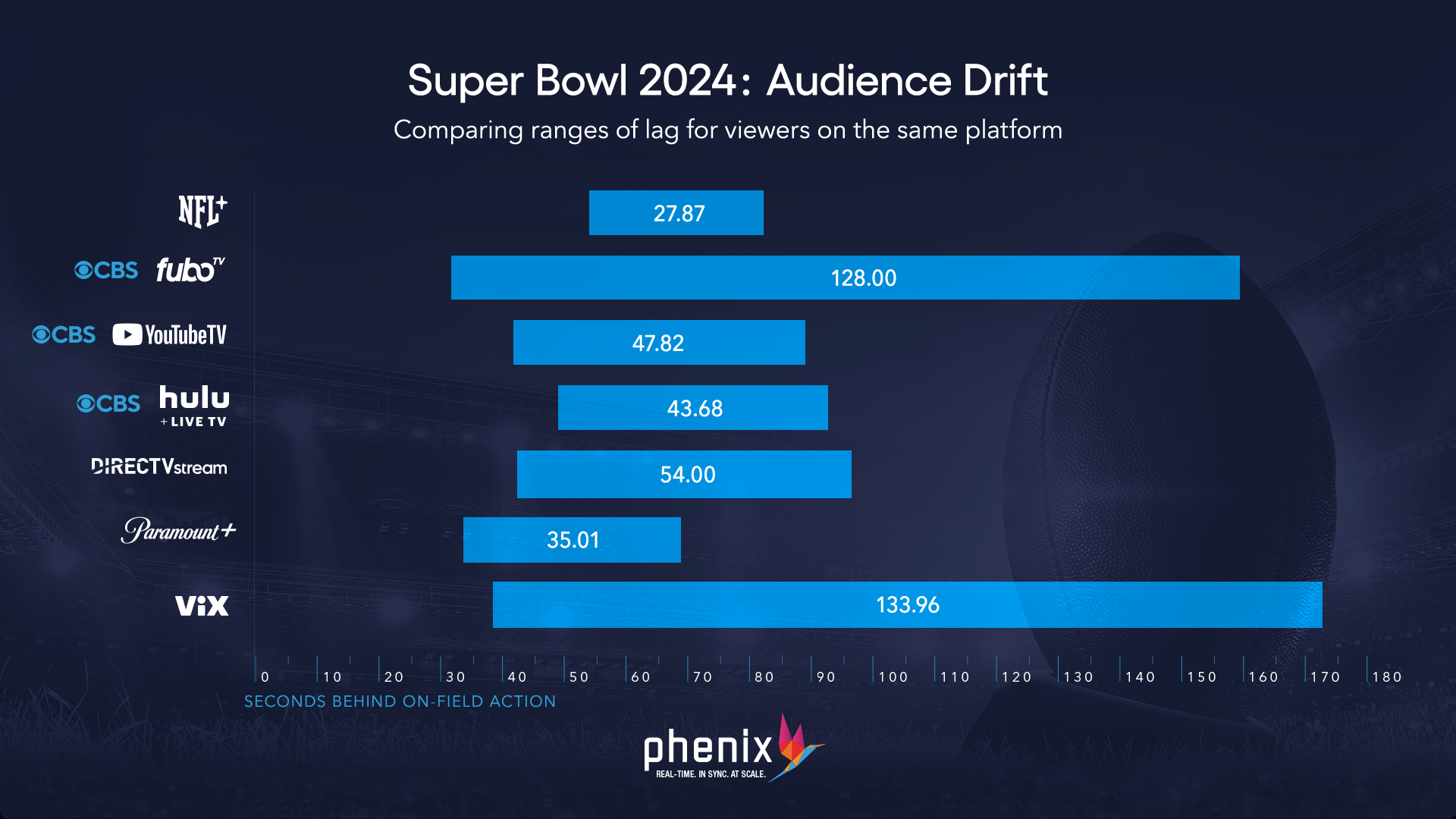For the fifth consecutive year, the streaming latency experienced during the Super Bowl ranged from 42.73 seconds to 86.75 seconds.
While some may argue that real-time streaming is only crucial for sports betting, the truth is that it plays an important role in enhancing the overall experience of live sports for all viewers. In today's digital age, practically everyone engages in social media while watching a game, making it the epitome of interactivity. Whether it's texting, tweeting, chatting, or simply watching together, these activities have become commonplace. However, if everyone you're hanging out with is watching the game at different times, it can significantly diminish the experience. Real-time video streaming ensures that viewers can fully engage with the game and avoid any spoilers or missed moments.
Super Bowl latency is a particularly hot topic because it’s the highest-profile event of the year. Comparing latency, or the delay sports fans see between what happens on the field and when it shows up on their device of choice, remains inconsistent due to the nature of the technology used for live streaming today.
At Phenix, we’ve been performing our Super Bowl Latency Study for the past several years. Our 2024 Super Bowl Latency Study averaged 173 data points from fans around the country by measuring the delay sports fans observe from the field of play to an end-user's device, not just the delay from cable and OTA to the user.
We have people at the game each year, so we get an accurate measurement of real-time sports delivery from the field of play to the various cable, over-the-air (OTA), and satellite sports broadcasts.
This year, OTA sports broadcasts averaged 22.19 seconds behind the field of play, cable had an average delay of 50.4 seconds, and fiber had a 29-second delay that sports fans had to tolerate. Then we measure the streams from cable, OTA, and satellite sports broadcasts to each streaming provider.
This year, we measured video streaming latency for:
- NFL+ mobile app
- CBS on YouTubeTV
- CBS on Hulu+ Live TV
- DirecTV Stream
- CBS on fuboTV
- Paramount+
- ViX / ViX+ (Spanish language channel)

Paramount+ delivered the lowest latency by far, with an average live streaming delay of 42.73 seconds behind the field of play. We were encouraged by this, but not entirely surprised since CBS carried distribution rights for the game.
Unfortunately, drift for Paramount+ averaged 35.01 seconds, with a range of 34-69 seconds - this measurement is taken from the user with the fastest stream to the user with the slowest.

If two friends were trying to watch the game together from different locations and they were both watching Paramount+, they could still see the action more than a minute apart. Imagine finding out about Kansas City’s stunning drive in the last few seconds of overtime via group chat instead of seeing the action for yourself.
Interestingly, two of the video streaming platforms closest to the NFL, NFL+ and YouTube TV (YouTube recently signed a long-term deal with the NFL to stream the Sunday Ticket package), had disappointing results.
The NFL+ app averaged a live streaming delay of 61.45 seconds behind the field of play, with YouTube TV averaging 55.54 seconds behind the field of play.
Conclusion
Other key takeaways from our latency research over the past several years include:
- The discussion of low latency streaming has grown immensely in the video streaming engineering community, yet overall latencies for major sporting events like the Super Bowl have NOT improved.
- Average Super Bowl streaming latencies have grown from between 42-46 seconds in 2021 to 56-87 seconds seconds in 2024 (excluding Paramount+ at 42.73 seconds)
- Paramount+ was the outlier, having improved this year’s overall latency to under 45 seconds which is approximately 30+ seconds better on average than all other streaming providers
- Average cable delay behind the field of play was 50.40 seconds, but it was as high as 79.92 seconds for some viewers
- Average fiber delay (Verizon Fios) behind the field of play was 29.00 seconds
- Average over-the-air (OTA) delay behind the field of play was 22.19 seconds
Several other organizations measure streaming delays for the Super Bowl including nScreenMedia and The Streamable. But without having someone at the stadium to get a real-time measurement to compare to, these are not accurate.
- The latency measurements are taken from the sports broadcast - either cable or OTA - to the user’s device and NOT from the field of play. This is significant because it doesn't fully account for the fan’s experience with the myriad of spoilers that can come from any direction.
- More data points are required to rule out anomalies and get an accurate picture of the audience experience.
- The discrepancies in numbers produced by studies like these highlight the very real phenomenon of drift.
Regardless of latency testing methodology, imagine if you were watching the game on one of these apps - or any of the streaming providers for that matter - and heard about the perfectly executed game-winning drive in the last few seconds of overtime 50+ seconds BEFORE you actually saw it happen! This is a terrible experience for sports fans and doesn't need to happen anymore.
It’s common for sports enthusiasts to enjoy the game using a variety of sports broadcasts and game data from mobile apps while watching a game. With Super Bowl latency this high, you have to turn off your notifications or your experience is ruined. Taken to another level, imagine if you were betting on it!



